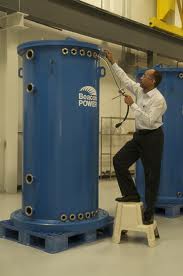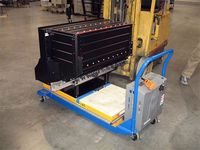Think of this as Volume 17, Number 17 of A-Clue.com, the online newsletter I've written since 1997. Enjoy.
 While most attention in renewable
While most attention in renewable
energy is focused on solar panels, or wind turbines, or the use of
pine pellets and algae for fuel, the real sweet spot is in storage.
Imre Gyuk , energy storage program manager at the Department of Energy, says
it's not just because solar and wind are intermittant. It's also
because an increasingly computer-driven society requires cleaner
power.
You know this in your own life. If you
have a desktop PC, chances are you have a Uninterruptible Power
Supply (UPS) sitting under your desk, or at least a “power
conditioning” power strip next to you – maybe both. Spikes can
damage critical components.

that realy cost are the short ones,” Gyuk noted. “It can bring a
production line to a grinding halt.” He said outages cost the U.S.
economy $79 billion annually, against a total cost of electricity of
$250 billion. The opportunity is being seized, and there's now a
large energy storage industry, which grew from 370 Mw under
management in 2011 to 686 Mw in March, 2013. But compare that to the
roughly 370 GW of power load required by the U.S. electrical grid –
that's ongoing load, not just potential production. There's a lot
more growth to come.
And that's why Bill Gates has put money
into Aquion,
a company developing batteries made of cotton, carbon and manganese
oxide, with salt water as its electrolyte instead of acid. It's why
he has also put money into Ambri and its liquid metal battery, as well as Light Sail Energy,
which is working on air storage.

economic success right now is Gyuk's work in bringing storage to bear
on our electric grid. DoE now has 111 storage projects going on,
against 30 in the rest of the world. Some of Gyuk's investments have
been failures, like Beacon Power, which went bankrupt despite
installing its flywheel technology near Albany, NY,
or A123, which is now owned by a Chinese outfit but has 32 Megawatts
of storage online in West Virginia.
Or Zinc Air,
a company the DoE isn't currently backing, which is working on
zinc-iron redox flow technology.
Gyuk estimates that for every 1 Mwatt
of grid energy, we need about 200 Kwatts of storage, storage that can
be turned on-and-off like flicking a light switch, in order to even
out power fluctuations. By contrast, what GE is offering, natural gas
back-up for renewable energy sources, is highly inefficient. It can
take a half-hour to bring even a natural gas turbine online, Gyuk
said, and the grid needs a much faster response.
A simple regulatory change can make a
huge difference in getting this storage online, increasing the prices
storage systems can charge for their services. One such change is
currently before Congress in the form of HR 1465, an Investment Tax
Credit for batteries. Another was FERC 890, a Department of Energy
pay-for-performance plan on grid storage that doubled profit for
storage companies at a stroke.
Lithium ion batteries have been getting
a lot of headlines lately. They're used in your iPhone, and in the
Boeing 787 Dreamliner. They're not perfect, but they can be recharged
again-and-again, which is a key to success in this field.
Energy can be stored-and-forewarded on
a grid-level, on a community level, or on an individual level. Gyuk
offered an example of how individual energy storage might work.

instead of just selling batteries in their electric cars, simply
lease them for five years. A lithium ion car battery loses just 20%
of its re-charging power in that time, Gyuk said, meaning its range
declines by that amount. If the battery is sold, the owner may keep
using it another year, or two, or three, accepting the lower range to
save a few bucks. But the battery that comes in after such overuse
has uncertain characteristics. If you lease the battery and take it
back after that time, it still has about 80% of its capacity, and can
be comfortably used in a grid energy storage system – on a large
scale, a community scale, or even on an individual scale. (It could
be tested, re-packaged, and re-sold for storing solar energy, for
instance, as its original value would have been fully depreciated.)
The battery opportunity is what makes
stories like this one,
from the University of Illinois, so important. By applying
nanostructure science to the cathodes and anodes in batteries, the
Illini have able to make lithium-ion “microbatteries” that can be
combined to store far more energy, and which charge 1,000 times more
quickly, than other designs. Without using different materials, in
other words, we can dramatically increase the storage density of grid
batteries, at low cost.

there may be graphene, which you can think of as a Buckyball that has been turned into a
sheet. It exhibits the same hexagonal structure you find on old
soccer balls, and can be produced with a simple DVD burner.
Graphene has its weaknesses – it can lose its structural integrity
at the edge of sheets, creating a “windshield crack” effect
across the sheet that may cut its effectiveness in half – but the material's opportunities are so vast that these kinks
are being ironed out quickly, on a global basis. One way to do that:
manage it alongside other materials like silicon.
“As energy storage becomes more
important companies will come out of the woodwork,” Gyuk concluded
in an Atlanta talk I covered recently. The DoE maintains a great site
about its energy storage experiments at energystorageexchange.org.
This is the sweet spot right now in
renewable energy, the point where the bleeding edge of technology
meets real business needs, and where profit opportunities are vast
for the most cost-effective solution. Storage today is where basic
solar was at the turn of the century, but it may develop twice as
fast.










